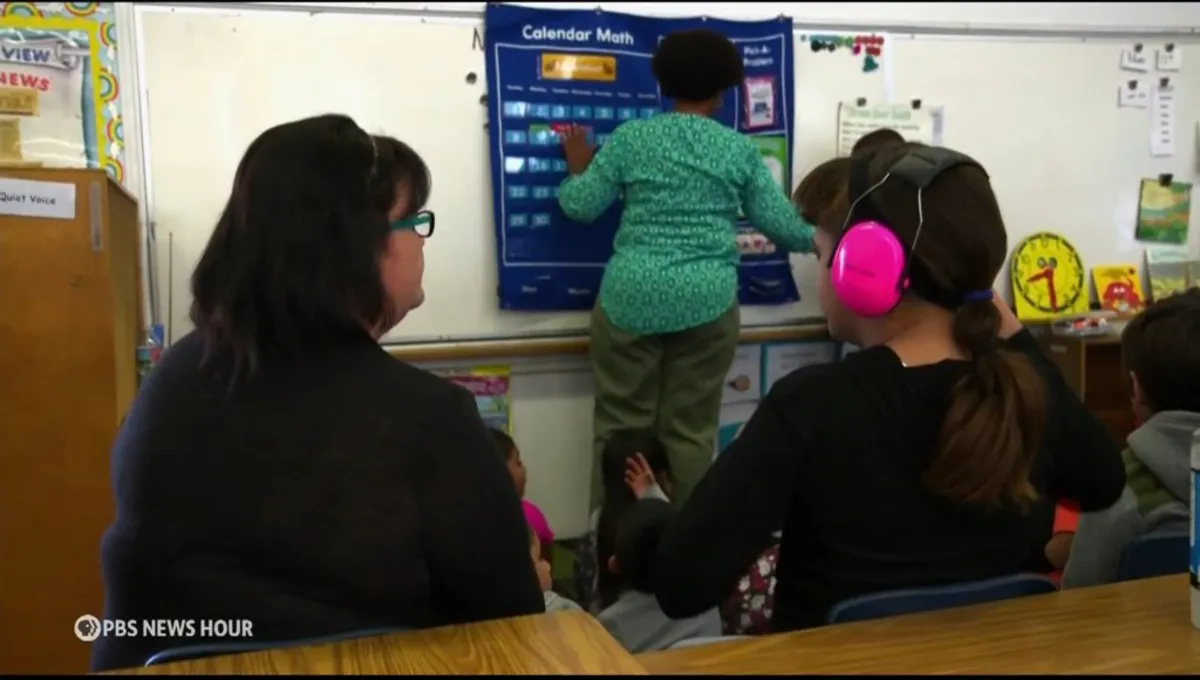
Geoff Bennett: As the Trump administration continues to downsize and dismantle many government agencies, the Department of Education could be next on the chopping block. This puts at risk the resources and support for more than seven million students with disabilities who depend on the agency to ensure access to a free public education. This is especially critical at a time when there is already a struggle to receive quality schooling due to a shortage of special education teachers. Judy Woodruff reports as part of our series Disability Reframed.
Judy Woodruff: Fourteen-year-old Spencer Nichols loves taking care of his farm animals at home in Macon, Georgia. It's a welcome break after a long school day where he has little autonomy. Spencer has Down syndrome and spends almost his entire day in a small classroom with other students with disabilities.
His mother, Pam Nichols, expresses concern that he's denied the same chance to succeed as his non-disabled peers. She notes that he can't choose his elective classes and isn't progressing as he should.
Pam Nichols, Mother of Spencer Nichols: “There are six students, and they're all taught at the same level. I have to challenge the school to use the data from testing to show that Spencer can read at a third- or fourth-grade level. These are appropriate books. It stalls his development and doesn't necessarily prepare him for society.”
Unfortunately, Spencer is only allowed in the general education classroom for his science class. Pam Nichols recounts a conversation with the teacher about an upcoming science test.
Pam Nichols: “I messaged the teacher and asked what I should focus on for Spencer. The teacher said Spencer would color during the test. I said, well, you don't understand. I want him to learn this.”
In 1975, President Gerald Ford signed a landmark federal law granting students with disabilities the right to a free public education in the least restrictive environment. When Congress passed the law, it promised the federal government would cover 40 percent of the average per-student cost. However, nearly 50 years later, federal funding stands at just about 10 percent. As a result, the majority of the funding comes from state and local sources, stretching thin public schools that are legally required to provide this education.
David Bateman, American Institutes for Research: “They aren't able to adequately fund appropriate one-on-one services for these kids, some of whom absolutely need this to progress in the curriculum. The attitude and tenor set by a building-level administrator flow through everything. If everyone treats it as these kids are part of our class, it sets a positive tone.”
About 20 miles south of Atlanta in Jonesboro, Georgia, 17-year-old Todd Estes shares his experiences in schools where he doesn't feel valued. Todd has ADHD and a learning disability that affects his comprehension of new concepts.
His mother, Priscilla Estes, says some of his general education teachers weren't well-trained to approach Todd's learning differences.
Priscilla Estes, Mother of Todd Estes: “They called me because Todd was underneath the table in class crying and wouldn't come out. I knew that adults would say discouraging things instead of encouraging them. It hinders learning going forward because if you hear you're a bad student or cannot learn, which my kids were actually told…”
Priscilla Estes: “I couldn't see Todd going to the next public school in sixth grade with a larger amount of students, which also means dealing with more stressed teachers.”
President Donald Trump has expressed intentions to close the Department of Education, describing it as a "big con job."
David Bateman: “They would then probably have to provide much larger class sizes, cut extracurricular activities, and other educational aspects. The federal government flows money from the U.S. Department of Education to the states, which then flows to local school districts. In exchange, local school districts must justify their actions to the state.”
Judy Woodruff: The challenges extend to educators as well. Criscilla Green, a special education teacher, often takes work home, cutting into family time.
Criscilla Green: “If I had to count, I would say I work at least seven to 10 hours a week at home. When I started education, my caseload was about six to seven students. Now we're up to 12. More students mean more data, more meetings, and more one-on-one support.”
We're dealing with many children struggling to self-regulate due to being home during COVID and not learning problem-solving skills. The behaviors are often reactions because they can't grasp the material. This makes classroom management challenging.
Gracie Kitrell emphasizes the importance of training in low-pressure environments, which benefits real classroom teaching. However, as the demand for special education teachers rises, schools struggle to keep up.
It's why Pam Nichols in Macon advocates for more resources, not less, for students with disabilities. She believes President Trump's proposal to cut the Department of Education makes them even more vulnerable.
Pam Nichols: “It's scary. In Macon, the public school system is the only option for Spencer. We've learned from the days when children like Spencer were institutionalized and didn't learn to read. Through early intervention services, they now are reading and doing math. They can be meaningful contributors to society. We just need to give them a little extra, and it will go a long way.”
Spencer has ambitions of owning a home and working in the restaurant industry. Pam is committed to fighting for his quality education to help him achieve his dreams.
For the PBS News Hour, I'm Judy Woodruff in Macon, Georgia.